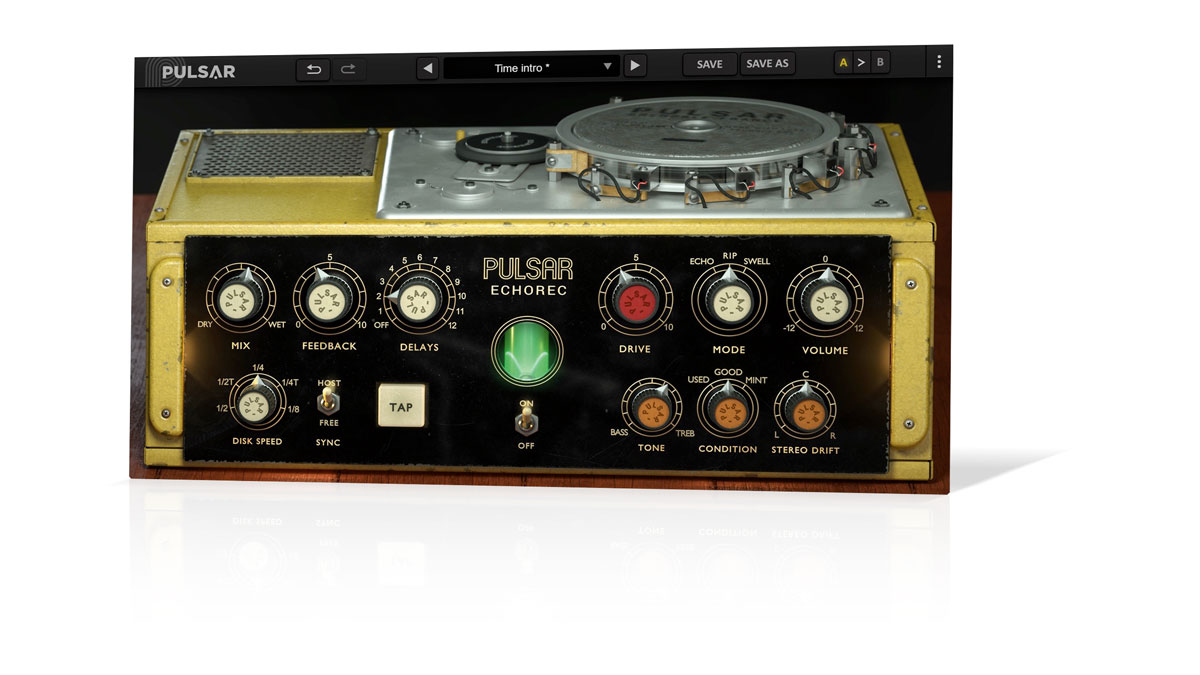MusicRadar Verdict
A fabulous addition to any producer’s ‘analogue’ delay plugin roster, Echorec is a top-notch emulation of a bona fide classic.
Pros
- +
Captures the sound, look and spirit of the original hardware.
- +
Condition and Stereo Drift are great.
- +
Tap tempo is handy for live use.
- +
Manual disk braking is cool.
Cons
- -
Individual heads aren’t as adaptable as other Echorec plugins.
MusicRadar's got your back
The debut from plugin developer Pulsar is an emulation of the legendary Binson Echorec 2 magnetic drum delay unit, as made famous through the 60s and 70s by the axe-wielding likes of Pink Floyd’s Dave Gilmour, Led Zep’s Jimmy Page and The Shadows’ Hank Marvin.
Known at the time for its comparatively consistent sound and characterfully rhythmic head positioning, these days a second-hand one will set you back around £2500, so a quality software version is always of interest. Pulsar’s claims to be the most realistic yet, accurately modelling everything from the tube amp to the motion of the drum itself.
Head games
Echorec’s (VST/AU/AAX) delay line comprises a record head and four play heads, the latter authentically fixed in their relative positioning around the rotating drum. Unlike the real thing, however, Pulsar’s version allows for adjustment of the speed at which the drum rotates, and thereby the timebase for the delay as a whole. This can be done freely by turning the Disk Speed knob or clicking the Tap button, with a range of a quarter to double the default speed; or synced to host tempo, at 1/2, 1/2T, 1/4, 1/4T and 1/8 note values, with 1/4 being the default (relative to tempo).
The play heads are configurable in a dozen single- and multitap delay patterns with the Delays knob. Helpfully, each one lights up briefly to show their active status as the knob clicks through each configuration. The ‘Off’ setting deactivates all four, giving just the sound of Echorec’s tube amplification, which is wonderfully warm and crunchy, and governed in intensity by the Drive knob.
Founded by Dr Bonfiglio Bini in the 1940s, Italian manufacturer Binson launched the Echorec in the late 50s, and followed it up with the Echorec 2 in 1961. Thanks largely to its association with Pink Floyd, who very much made it an integral part of their sound, the Echorec 2 became a hit and sold in considerable numbers until 1979.
Taking a different approach to the dominant tape delays of the time, the Echorec eschewed magnetic tape for a far more hard- wearing motor-driven metal drum with a magnetic metal strip wrapped around it. The record and playback heads, used to write to and read from the magnetic strip, were arranged around the edge. The motor ran at a fixed speed, and the play heads were placed for delay times of 75, 150, 225 and 300ms. So with head 4 at a quarter-note, the other three represented an eighth-note, a dotted eighth- note and a 16th-note. All of this is recreated and expanded on in Pulsar’s plugin.
Three Modes - Echo, Rip and Swell - establish the routing and feedback behaviour of the delay line. In Echo mode, the Feedback control has no effect - you only ever get one tap per head. Rip mode is your standard feedback delay, with the active heads feeding back into the input via the Feedback knob (which ramps up to wicked self- oscillation, just like the hardware). And Swell mode is the same as Rip mode, but with all four heads feeding to the output regardless of the Delays setting - intended for small room reverb, but creatively useful beyond that, too.
Basic equalisation is provided by the Bass/ Treble Tone control, and further sonic colouration beyond the tube saturation is on hand in the three Condition settings: Used, Good and Mint. As their names describe, these model the circuitry of three differently-aged units, improving in high-end fidelity and head/timing alignment from Mint to Used.
Also going some way beyond the capabilities of the hardware, Stereo Drift applies a tiny timing offset to the left or right channel, artificially but very effectively widening the sound when used on a stereo track. And clicking and holding on the drum slows it down by an amount that’s determined by the distance of the pointer from the centre - fun, if a little bit on the gimmicky side.
Bin’ it!
Echorec is a beautiful take on Binson’s inventive box, with an impressively ‘analogue’ sound (dark yet lively, to characterise it) and welcome modernisation in its ‘added’ features. We’d like to have seen some measure of independent control given over individual heads - as offered by rival plugins - but we suppose purists might actually see that omission as a plus.
Computer Music magazine is the world’s best selling publication dedicated solely to making great music with your Mac or PC computer. Each issue it brings its lucky readers the best in cutting-edge tutorials, need-to-know, expert software reviews and even all the tools you actually need to make great music today, courtesy of our legendary CM Plugin Suite.
“We were arguing a lot and we were miserable”: How Green Day exceeded expectations with their most ambitious song
"There’s plenty for us guitarists to learn – and ‘less is more’ is the overriding lesson": how to play like George Harrison on The Beatles' Abbey Road
“They didn’t like his bikini underwear”: Prince’s support sets for the The Rolling Stones in 1981 are remembered as disastrous, but guitarist Dez Dickerson says that the the crowd reaction wasn’t as bad as people think











